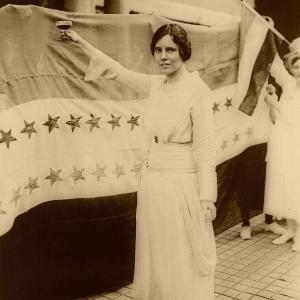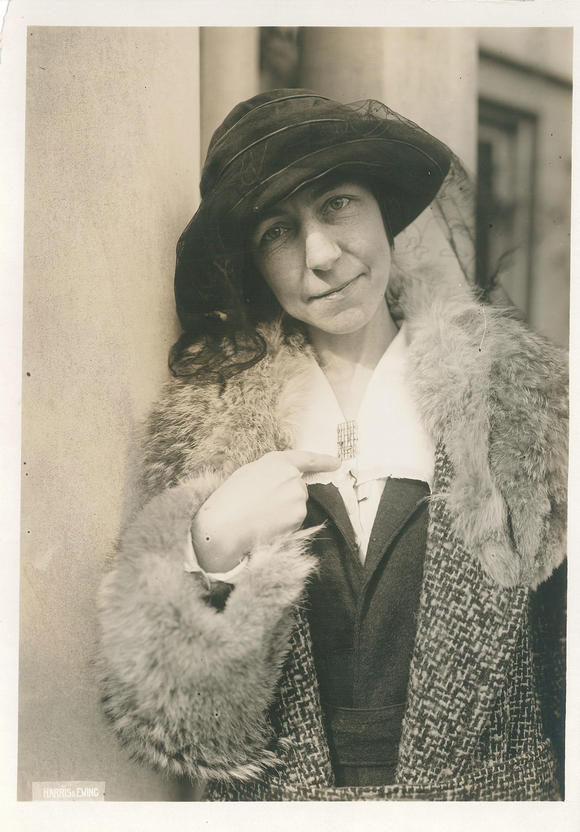Overview
The battle over equality of the sexes is one that has permeated the 20th century. The 1920s were a turbulent and successful decade for women’s rights, signaling a dramatic shift in female politics, social status and what the future of feminism might look like. During this period women were embracing the freedoms and independence of post-war America, and as a result began to question the social, cultural and political boundaries they faced based on their gender.
Famously passed in 1920, the 19th Amendment granted women the right to vote for the first time in American history. After decades of protests and legal obstacles, suffrage was finally realized throughout the country. However, the fight for equal rights didn’t stop there. Despite the 19th Amendment being ratified, there continued to be countless gender based desriminations related to a woman’s work, finances, personal life and body.
The second decade of the 20th century saw women getting involved in politics and policy like never before in American history. Women were able to meet, organize and plan movements that would improve their lives and remove them from second-citizen status.
During the 1920s the National Women’s Party, which had originally been founded on the basis of suffrage, adopted a new goal. These post-suffrage feminists , including one of the NWP’s founders Alice Paul, believed that true equality could only be achieved through absolute legal protection. In December of 1923 the Equal Rights Amendment was introduced to congress for the first time.
The document presented to congress in 1923 fared some changes to the original bill drafted by activist Alice Paul and lawyer Crystal Eastman. Titled the “Lucretia Mott Amendment,” the document stated that “men and women shall have equal rights throughout the United States and every place subject to its jurisdiction.” If the amendment were to be passed it would open the doors to women’s rights issues. The broad nature of the document as well could guarantee victory as it related to gender based discrinimation in the future.
A Brief History of Suffrage
One of the most defining events of the Suffrage Movement occurred in 1848, where a group of abolitionists organized for the first time in Seneca Falls, New York at would be remembered as the infamous Seneca Falls Convention.
It was at there that activist created the Declaration of Sentiments, which stated that “all men and women were created equal,” despite what the founding fathers may have written in the constitution. By 1890 the National American Women Suffrage Association was formed. After over a decade of protest and activism across the country, the 19th Amendment was ratified by congress on August 18th, 1920.
Alice Paul (1885-1977)
Alice Paul was a prominent player in the fight for Suffrage, as well as a pioneer of the Equal Rights Amendment. Born in Mount Laurel, New Jersey, Paul spent the majority of her life surrounded by the belief that women were equal to men as both her parents greatly encouraged gender equality. In 1916 Paul co-founded the National Women’s party with activist Lucy Burns to organize on the basis of securing women the right to vote. After securing victory in regards to voting rights, Paul directed her efforts towards the Equal Rights Amendment.

Crystal Eastman (1881-1928)
Eastman co-founded the American Civil Liberties Union in 1920 and was a prominent leader in women’s suffrage throughout the 1920s. Eastman participated in and helped run multiple social movements during her life including suffrage, internationalism, socialism and pacifism. After the ratification of the 19th Amendment Eastman foresaw that the right to vote would not guarantee women protection and equal liberties under the law. Eastman believed that women rights groups needed to begin working towards equal rights rather than just voting rights.
Eastman and Paul shared similar goals as they related to what the future of the women’s movement should look like. While the majority of suffragettes saw the 19th Amendment as a victory, Eastman knew that it was just the beginning of a longer and bigger fight for equality.
“The principle of the Equal Rights Amendment is supremely important. The very passion with which it is opposed, suggests that it is vital.”
On Women and Revolution(Crystal Eastman)

The Joint Resolution (1923)
Direct in nature, those who wrote and presented the ERA demanded immediate action against gender based discrimination. High off the tail of the 19th Amendment, Paul and other former suffragettes saw passing the ERA as the next logical step.
In order for the resolution to reach congress, the NWP used activists Susan B. Anthony’s nephew, Daniel Anthony Jr. to introduce the document. The Joint Resolution as seen below proposes a 20th amendment to end discrimination on the basis of sex. The document was received in congress December 13th, 1923.

Reactions to the E.R.A
After its release it’s fair to say that the ERA was not popular in congress, nor amongst the general public. Many still believed that women belonged in the home, and should remain dependent on men. Traditionalists fought against the ERA in an effort to ensure the stability of gender roles. On the other hand, members of the feminist movement argued against the amendment becasue they felt the NWP was failing to concider both the racial and class lines that divided the party.
During this time working class and immigrant women had directed their attention towards child labor laws and safety conditions in facroties. It would be even more difficult to raise these issues if former suffragettes began to demand an Equal Rights Amendment. Labor activists in particular feared that the protections they had won for female workers would be jeopardized if the ERA was passed. These opposite opinions caused divided within the NWP, causing many to leave due to the direction the party was headed.
Something else the ERA failed to consider was that despite the 19th Amendment, women of color were still unable to vote due to racial discrimination. By focussing all their efforts on the Equal Rights Amendment, the NWP failed to consider the legal discrimination based on race that still occurred in the United States.
The ERA in the 1920s was a failed endeavor. Despite the efforts made by Paul and other activists, lack of support for the amendment stunted it’s progress. Although instances of resurgence would occur in future decades, it wouldn’t be until the 1960s and 1970s that the ERA would enter the minds of a new generation of feminists.
Second Wave Feminism and the E.R.A
The various social and political turmoils of the 1960s and 1970s caused the Equal Rights Amendment to re-enter the public sphere. Piggybacking off of the Civil Rights Movement and Second Wave Feminism, the ERA made its way to politicians reacting to the current social changes throughout the country.
The amendment was passed by congress in 1972 and sent out for ratification at the state level. This process, although slower, has seen success over the decades since its administration.
There are currently 38 states that have passed the ERA, and of the states that have not there continue to be a push from modern feminists to reconsider the bill each year. The most recent state to approve the bill is Virginia, who ratified the ERA in January 2020.
The E.R.A, 1920s and Feminism
When looking back at the women’s rights movement of the 20th century, the Equal Rights Amendment upon its release in 1923 resembles more of a short-lived blip in the larger scale of successful achievements made by suffragettes and feminists. One of the most defining legislations of the 1920s was the 19th Amendment, granting women the right to vote. Although women had been involved in politics for centuries, this shifted the political sphere towards women legally for the first time in American history.
The “New Woman” of the 1920s was someone who was independent, free and embodied radical ideas about modern femininity. The ERA in this regard signaled not just a shift in political power, but in social and economic as well. To ignore the ERA as a founding document of both the 1920s women’s movement and second wave feminism is to bypass the first goal set by the National Women’s Party after achieving suffrage. Ending sex based discrimination was a radical belief during this decade, yet activists like Alice Paul and Crystal Eastman continued to push forward the bill despite constant rejection.
The failure of the ERA on the heels of the 19th Amendment is a reminder of the content hurdles women during the 1920s faced. Few success were granted towards feminist causes, leaving progress to be a slow and painful journey. Throughout American history the ERA adapted and changed to fit a 21st century mindset, but the original ideas fortified in 1923 remain protected by time.
Sources
H.J. Res. 75, Proposing an Equal Rights Amendment to the Constitution, 12/13/1923 https://catalog.archives.gov/id/7452156
Here’s What to Know About the History of the ERA: https://time.com/5657997/equal-rights-amendment-history/
Kyvig, David E. “Historical Misunderstandings and the Defeat of the Equal Rights Amendment.” The Public Historian 18, no. 1 (1996).
American Civil Liberties Union: Crystal Eastman https://www.aclu.org/issues/free-speech/crystal-eastman-aclus-underappreciated-founding-mother
National Women’s History Museum: Alice Paul https://www.womenshistory.org/education-resources/biographies/alice-paul
Smithsonian: History of the Equal Rights Amendment https://www.smithsonianmag.com/history/equal-rights-amendment-96-years-old-and-still-not-part-constitution-heres-why-180973548/
The Fight For Women’s Suffrage https://www.history.com/topics/womens-history/the-fight-for-womens-suffrage
States That Have Not Ratified The ERA https://www.cnn.com/2018/05/31/us/equal-rights-amendment-illinois-states-trnd/index.html
Crystal Eastman. On Women and Revolution. Edited by Blanche Wiesen Cook. New York: Oxford University Press. 1978.
Senior History and American Studies student at Ramapo College of New Jersey enrolled in Discovering Digital History course taught by Dr. Hajo during Spring 2021.

